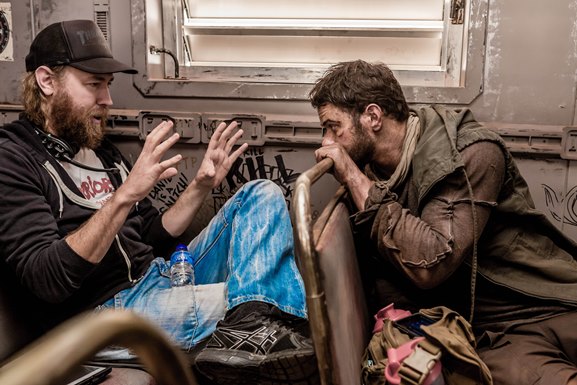The new Aussie feature ‘The Osiris Child: Science Fiction Volume One’, starring Kellan Lutz, Daniel MacPherson, Luke Ford and Rachel Griffiths, is set in a future where interplanetary colonisation is common.
It tells the story of a drifter (Lutz) who teams up with an off-world military contractor (MacPherson) to rescue his daughter.
Director Shane Abbess ('Infini', 'Gabriel') spoke to IF after wrapping up a roadshow of the film, which premiered in Australia at last month’s Gold Coast Film Festival after bowing at Austin’s Fantastic Fest last year.
The director and cast also participated in Q&As at Sydney and Melbourne screenings ahead of the film’s national release in Event and Village Cinemas on May 18.
What’s the response to the film been like?
Shock. The consistent thing is that people are surprised by the scope of the movie, because it’s quite large, and also the depth of performances. I knew these actors as people, and I felt that a lot of their humanity had never been shown in a movie. They’d never been pushed. And I knew from my last movie, Infini, where we adopted a very Australian way of doing things – in terms of full immersion, living on set – I knew that would help everybody with a film like this. Especially when everything’s working against you: the budget’s crazy tight, you’re a sci-film and you’re trying not to become a D-movie. We are a pulpy, Betamax, Sunday matinee film, but we do have a contemporary edge.
How did the script develop?
There was a really old script around called Last Stand, which had a family on a bus travelling through an apocalyptic wasteland. And then Brian [Cachia] and I had another script called Out of Order, which was based on the comics I had as a kid. I used to get them out of order, and I never really knew the origins of a character until I got to issue one. We combined both those ideas, and I pitched it to Brett [Thornquest] and Sid [Abbene] and Matt [Graham] and Steve [Matusko] and the whole team. It was a risky move to tell a film with chapters out of order. The original script was 15 chapters out of order.
Was it a challenge to raise the money?
No. The same team that financed Infini was right behind us to go again, because Infini had done quite well around the world, so it was kind of a no-brainer. Infini was designed to be an anarchy project; almost this protest against the typical formula and cohesion of structure. We wanted this one to have more of a commercial sensibility, but also have a narrative that was unpredictable. We were interested in the notion of taking a story and not giving you all of the information that you would normally want.
How did you measure how far you could push it without losing that mainstream audience?
Test screenings were hugely valuable. We tested every few months as we were editing and we’d get a really big audience – 100, 150 people. And it was always interesting. When we cut it like the script, people just had no idea which way was up. We’d gone way too far, and the process really was [about] trying to pare it back so that people had something to latch onto. A lot of people at festivals came back and watched it again, because you watch this film very differently when you know the end of it.
How long did you have to shoot?
We had eight weeks. No pick-ups, no overtime; eight weeks flat. I shot Gabriel in eight weeks, I shot Infini in 9 weeks, and this was a week less. I did feel on this one that there was no more room to squeeze anything else out of that budget and that crew. I think that’s where a lot of the pride on SFV1 comes from; we really took this one as far as you could stretch a budget. Even with the bus; it was a shell of a bus and then we built a sci-fi frame on it and had to ship it out to Coober Pedy. And it was the kind of film where you have one bus, four tires, one engine – if something went wrong, you couldn’t come back from that.
Where else did you shoot?
We had our own studio in Sydney where we converted a massive industrial space that was going to be turned into a Bunnings. We converted that into three different sound-stages. Same place we shot Infini. But we only had two stages on Infini, and now we have three plus a workshop.
How many in-camera effects were you doing?
There are 400 shots in the film that are CG, or CG-enhanced. But probably 250 of those have mostly practical elements to begin with. The creatures in the film were all practical. We only had one head that was animatronic and the rest were all moulds, so they had no movement inside them. We had to use a lot of old-school tricks to sell ideas of movement and action and things like that.
What’s next?
I have three different films right now [to choose from], things I’ve worked on for a long time. They’re shooting here but they’re bigger US, China-backed films.
* This interview has been edited and condensed.


